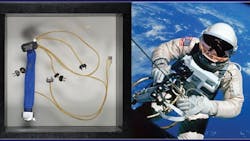Apollo 9 Space Cable Comes Home
Almost 50 years after an Apollo space walk, a long-lost flat cable harness returned back home to Cicoil. The “Bio-Harness” Assembly, built by Cicoil for the 1969 Apollo 9 Space Flight, was acquired by Cicoil in a NASA Apollo Space Program auction. “Amazingly, the harness looks virtually brand-new, considering its age and the number of miles it has traveled,” Cicoil said in a release.
The 26-inch long electrical biomedical harness was worn by Commander Jim McDivitt during the Apollo 9 flight, which launched into orbit on Mar. 3, 1969, and returned to Earth ten days later. Typically, the “Bio-Harness” was worn underneath the Intra-Vehicular Constant Wear Garment when in the spacecraft, and under the extra-vehicular (EV) pressure suit during spacewalk activities. The assembly enabled continuous monitoring of vital signs such as respiration, body temperature and pulse rate for each astronaut during flight, orbit and spacewalk operation. In addition to Commander McDivitt, astronauts David Scott and Rusty Schweickart also utilized bio-harnesses made by Cicoil on the Apollo 9 as well.
Cicoil’s bio-medical Instrumentation and telemetry harnesses were chosen by NASA for their ability to separately encase shielded signal pairs to eliminate electronic interference; provide uninterrupted signal integrity during the harsh rigors of space flight; exceptional performance when exposed to temperature extremes (-65°C to +260°C); resistance to UV Light, radiation and vibration; high efficiency in dissipating heat between inner cable components; highly flexible and lightweight materials; and high reliability in mission critical applications, Cicoil said.
In addition to every Apollo Space Flight, Cicoil has manufactured cable assemblies for the Mercury and Gemini space missions, Skylab, Mercury Voyager, the Space Shuttle program, Tri-ATHLETE Lunar Vehicle, the Mars Rover; and today are utilized on space transport rockets and satellites.
